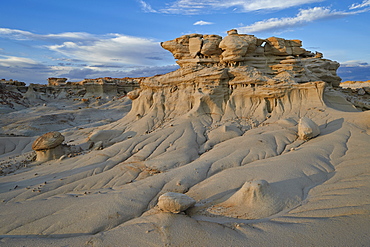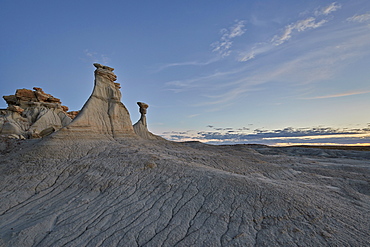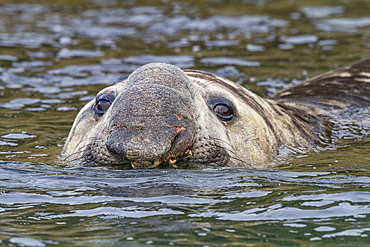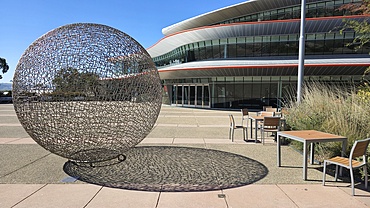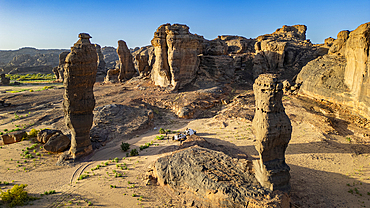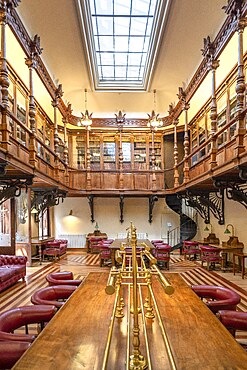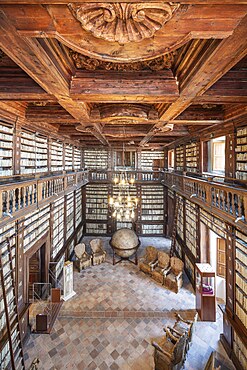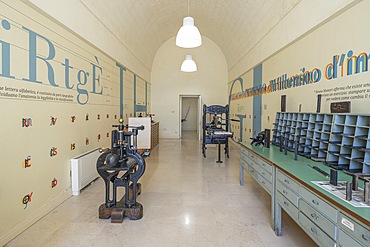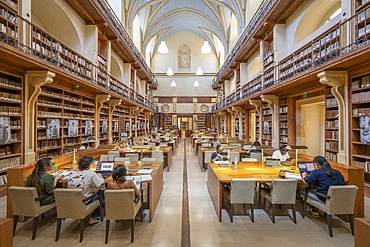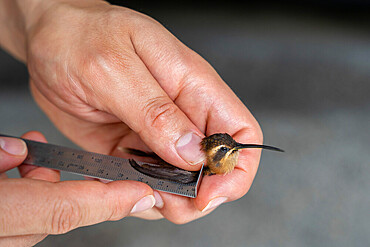Results
27 results found

Rocks in the badlands, Ah-Shi-Sle-Pah Wilderness Study Area, New Mexico, United States of America, North America
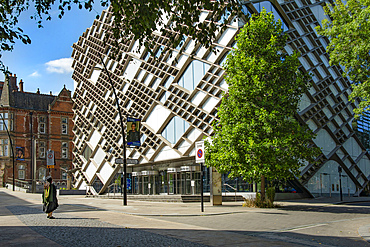
Diamond Building, housing Faculty of Engineering, University of Sheffield, Leavygreave Road, St. George's Quarter, Sheffield, Yorkshire, England
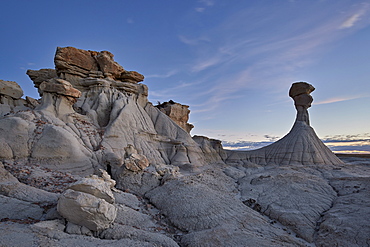
Hoodoo at dusk, Ah-Shi-Sle-Pah Wilderness Study Area, New Mexico, United States of America, North America

Rock formation in the badlands, Ah-Shi-Sle-Pah Wilderness Study Area, New Mexico, United States of America, North America

Library at Monasterio y Museo de la Recoleta, UNESCO World Heritage Site, Arequipa, Arequipa Province, Arequipa Region, Peru, South America
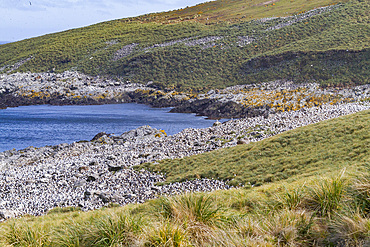
Black-browed albatross (Thalassarche melanophrys) breeding colony on Steeple Jason Island in the Falkland Islands

Nurse shark (Ginglymostoma cirratum), with boat in Hol Chan Marine Preserve, inside the Mesoamerican Barrier Reef, Belize
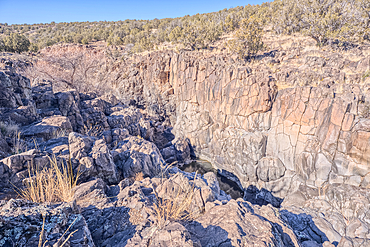
Dry waterfall cliffs, Johnson Canyon between Bainbridge Steel and Stone Dams near Ash Fork, Kaibab National Forest, Arizona, United States of America
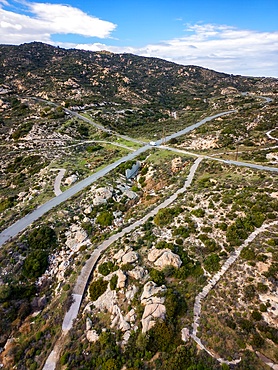
Drone aerial view of Kriaritsi project area with abandoned roads in the south of Greece, Sithonia, Chalkidiki, Greece

Students of all-female Gundi Pira Secondary School in earthquake devastated area of Pattika, Pakistan
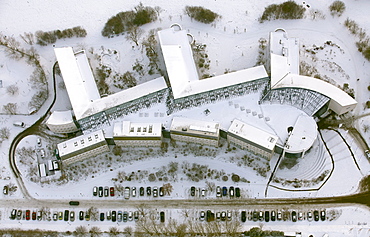
Aerial view, Private University of Witten Herdecke covered in snow, Witten, Ruhr Area, North Rhine-Westphalia, Germany, Europe
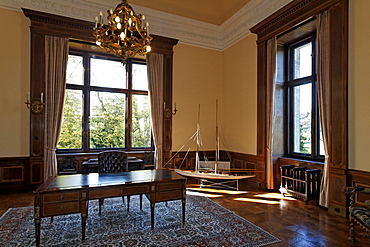
Study, Villa Huegel, former home of the Krupp family, Essen-Baldeney, North Rhine-Westphalia, Germany, Europe
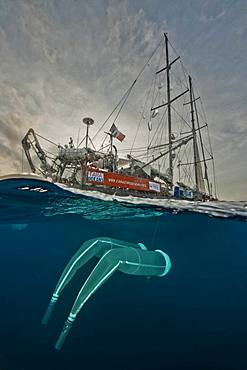
Tara Oceans Expeditions - May 2011. Tara with deployed plancton nets. On "station", the boat is drifting without engine or sails. Tara Oceans, a unique expedition: Tara Oceans is the very first attempt to make a global study of marine plankton, a form of sea life that includes organisms as small as viruses and bacterias, and as big as medusas. Our goal is to better understand planktonic ecosystems by exploring the countless species, learning about interactions among them and with their environment. Marine plankton is the only ecosystem that is almost continuous over the surface of the Earth. Studying plankton is like taking the pulse of our planet. Recently, scientists have discovered the great importance of plankton for the climate: populations of plankton are affected very rapidly by variations in climate. But in turn they can influence the climate by modifying the absorption of carbon. In a context of rapid physico-chemical changes, for example the acidification observed today in the world's oceans, it is urgent to understand and predict the evolution of these particular ecosystems. Finally, plankton is an astonishing way of going back in time ? a prime source of fossils. Over the eons, plankton has created several hundred meters of sediment on the ocean floors. This allows us to go back in time, to the first oceans on Earth, and better understand the history of our biosphere. More than 12 fields of research are involved in the project, which will bring together an international team of oceanographers, ecologists, biologists, geneticists, and physicists from prestigious laboratories headed by Eric Karsenti of the European Molecular Biology Laboratory. Galapagos
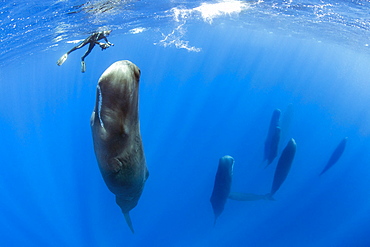
Snorkeler photographing a pod of Sleeping sperm whale (Physeter macrocephalus) Researchers first saw this unusual sleep behavior in sperm whales in 2008. The scientists in that study found that sperm whales dozed in this upright drifting posture for about 10 to 15 minutes at a time, Vulnerable (IUCN). The sperm whale is the largest of the toothed whales. Sperm whales are known to dive as deep as 1,000 meters in search of squid to eat. Dominica, Caribbean Sea, Atlantic Ocean. Photo taken under permit n°RP 16-02/32 FIS-5.

Pod of Sleeping sperm whale (Physeter macrocephalus) Researchers first saw this unusual sleep behavior in sperm whales in 2008. The scientists in that study found that sperm whales dozed in this upright drifting posture for about 10 to 15 minutes at a time, Vulnerable (IUCN). The sperm whale is the largest of the toothed whales. Sperm whales are known to dive as deep as 1,000 meters in search of squid to eat. Dominica, Caribbean Sea, Atlantic Ocean. Photo taken under permit n°RP 16-02/32 FIS-5.
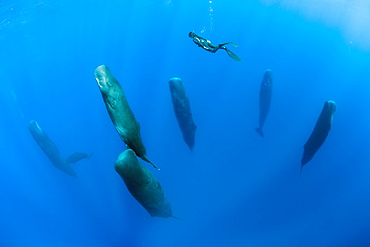
Free diver is swimming over a pod of Sleeping sperm whale (Physeter macrocephalus) Researchers first saw this unusual sleep behavior in sperm whales in 2008. The scientists in that study found that sperm whales dozed in this upright drifting posture for about 10 to 15 minutes at a time, Vulnerable (IUCN). The sperm whale is the largest of the toothed whales. Sperm whales are known to dive as deep as 1,000 meters in search of squid to eat. Dominica, Caribbean Sea, Atlantic Ocean. Photo taken under permit n°RP 16-02/32 FIS-5.
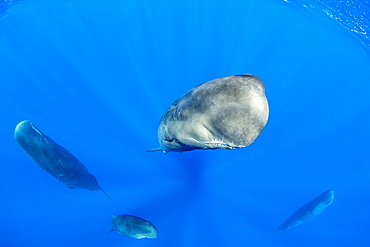
Pod of sperm whale relaxing after a short sleep (Physeter macrocephalus) Researchers first saw this unusual sleep behavior in sperm whales in 2008. The scientists in that study found that sperm whales dozed in this upright drifting posture for about 10 to 15 minutes at a time, Vulnerable (IUCN). The sperm whale is the largest of the toothed whales. Sperm whales are known to dive as deep as 1,000 meters in search of squid to eat. Dominica, Caribbean Sea, Atlantic Ocean. Photo taken under permit n°RP 16-02/32 FIS-5.

Pod of Sleeping sperm whale (Physeter macrocephalus) Researchers first saw this unusual sleep behavior in sperm whales in 2008. The scientists in that study found that sperm whales dozed in this upright drifting posture for about 10 to 15 minutes at a time, Vulnerable (IUCN). The sperm whale is the largest of the toothed whales. Sperm whales are known to dive as deep as 1,000 meters in search of squid to eat. Dominica, Caribbean Sea, Atlantic Ocean. Photo taken under permit n°RP 16-02/32 FIS-5.
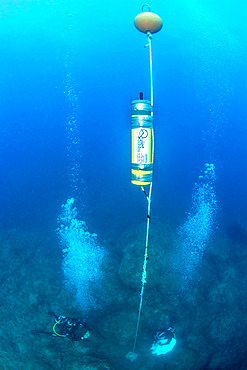
Installation of an acoustic recorder for the study of the frequentation and impact of acoustic diving, in the Natural Marine Reserve of Cerbere-Banyuls, Pyrenees-Orientales, Occitania, France
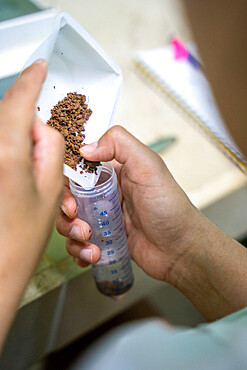
Earth diluted with water in order to extract the PH from the soil as part of a study on nitrogen exchanges between bacteria and the roots of legumes in the tropical forest of the "La Selva" research station in Puerto Viejo from Sarapiqui, Costa Rica
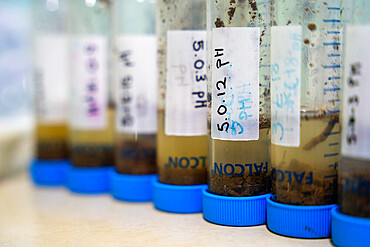
Earth diluted with water in order to extract the PH from the soil as part of a study on nitrogen exchanges between bacteria and the roots of legumes in the tropical forest of the "La Selva" research station in Puerto Viejo from Sarapiqui, Costa Rica
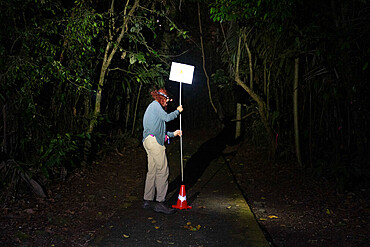
Installation of a sign on a hiking trail indicating the presence of nets to capture bats as part of a pollination study, rainforest of the "La Selva" research station in Puerto Viejo de Sarapiqui, Costa Ricardo
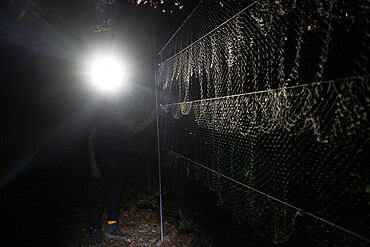
Net for catching bats as part of a pollination study, rainforest at the "La Selva" research station in Puerto Viejo de Sarapiqui, Costa Rica
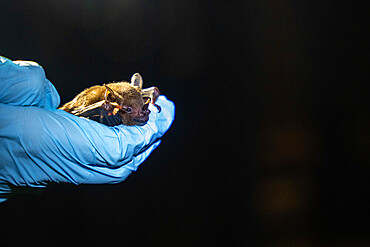
Sowell's short-tailed bat (Carollia sowelli) caught as part of a pollination study, rainforest at the "La Selva" research station in Puerto Viejo de Sarapiqui, Costa Rica
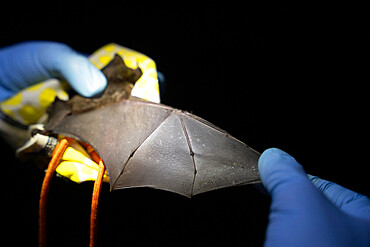
Sowell's short-tailed bat (Carollia sowelli) caught as part of a pollination study, rainforest at the "La Selva" research station in Puerto Viejo de Sarapiqui, Costa Rica
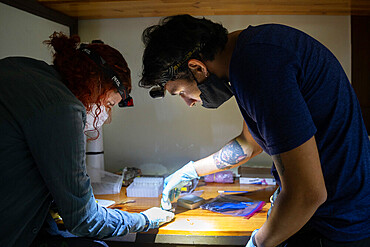
Researchers applying tape to the hairs of a bat to test methods to capture the pollen it carries as part of a pollination study, rainforest at the 'La Selva' research station in Puerto Viejo de Sarapiqui, Costa Rica
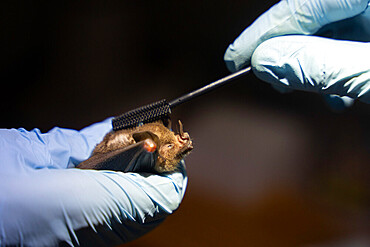
Researchers applying a mascara brush to the hairs of a Sowell's short-tailed bat (Carollia sowelli) to test methods to capture pollen that bats may carry as part of a pollination study, rainforest at the "La Selva" research station in Puerto Viejo de Sarapiqui, Costa Rica
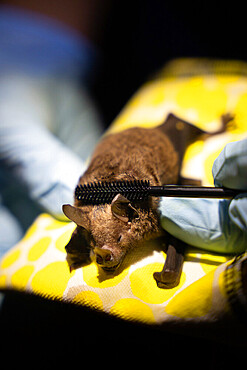
Researchers applying a mascara brush to the hairs of a Sowell's short-tailed bat (Carollia sowelli) to test methods to capture pollen that bats may carry as part of a pollination study, rainforest at the "La Selva" research station in Puerto Viejo de Sarapiqui, Costa Rica
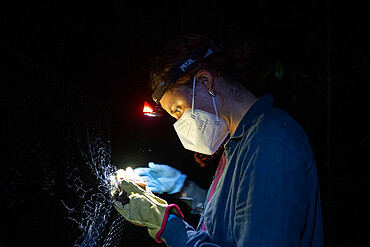
Researcher unhooking a bat caught in a net as part of a pollination study, rainforest at the "La Selva" research station in Puerto Viejo de Sarapiqui, Costa Rica
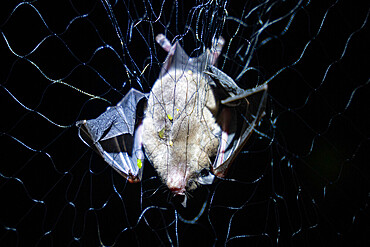
Bat caught in a net as part of a pollination study, rainforest at the "La Selva" research station in Puerto Viejo de Sarapiqui, Costa Rica
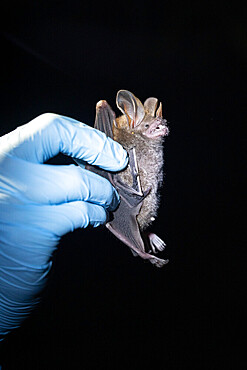
Fringe-lipped Bat (Trachops cirrhosus) in the hand of a scientist as part of a pollination study, tropical forest at the "La Selva" research station in Puerto Viejo de Sarapiqui, Costa Rica
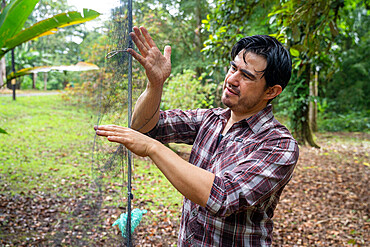
Researcher setting up a net to capture hummingbirds as part of a pollination study, rainforest at the "La Selva" research station in Puerto Viejo de Sarapiqui, Costa Rica
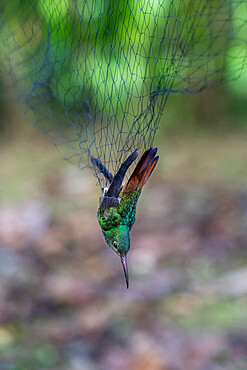
Rufous-tailed Hummingbird (Amazilia tzacatl) in a net set up by a researcher as part of a pollination study, rainforest at the "La Selva" research station in Puerto Viejo de Sarapiqui, Costa Rica
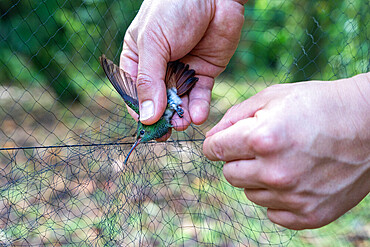
Researcher catching Rufous-tailed Hummingbird (Amazilia Tzacatl) in a net set up for pollination study, rainforest at "La Selva" research station in Puerto Viejo de Sarapiqui, Costa Rica

Researchers picking up pollen using tape on the beak of a Rufous-tailed hummingbird as part of a pollination study, rainforest at the "La Selva" research station in Puerto Viejo de Sarapiqui, Costa Rica
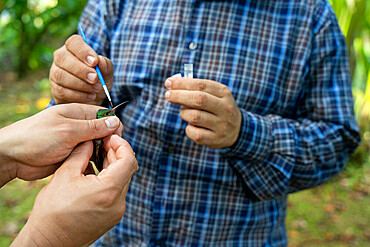
Researchers picking up pollen with a brush from the beak of a Rufous-tailed hummingbird as part of a pollination study, rainforest at the "La Selva" research station in Puerto Viejo de Sarapiqui , Costa Rica
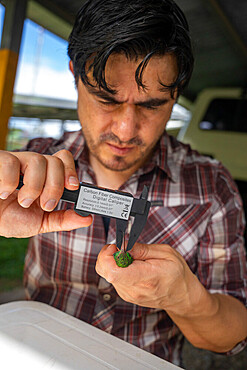
Researcher measuring the beak of a Rufous-tailed hummingbird as part of a pollination study, rainforest at the "La Selva" research station in Puerto Viejo de Sarapiqui, Costa Rica
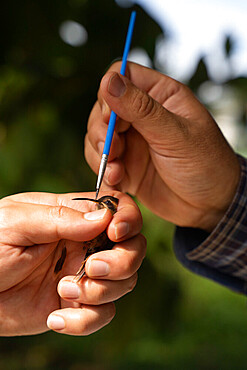
Researchers picking up pollen with a brush from the beak of a hummingbird Stripe-throated Hermit as part of a pollination study, rainforest at the "La Selva" research station in Puerto Viejo de Sarapiqui, Costa Rica

